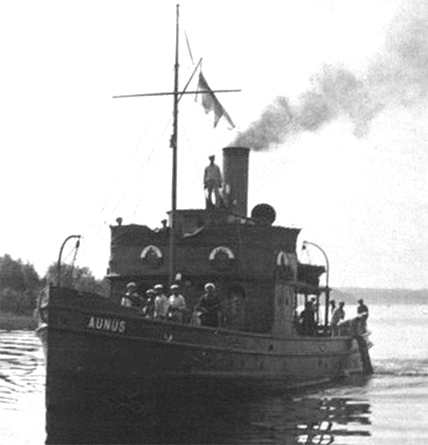Gunboat "Aunus" |
||||||||||||||||||||
|
The ice-breaking tug Aunus was built in Turku shipyard Wm. Crichton & Co Ab in 1900. In 1919, vessel fell into the hands of Finns in the flooded condition in Vidlitsa, at the Olonka River mouth, during the Olonets Expedition. It was reconstructed into gunboat and became a part of Finnish Ladoga flotilla. According to the conditions of 1920 Tartu Peace treaty between Soviet Russia and Finland the sides could not have in Ladoga Lake vessels with the displacement of more than 100 metric tons and armed with the guns of more than 47 mm. In accordance to that the gunboat Aunus had following parameters:
During 1939-1940 Winter War Aunus was a part of gunboats flotilla, commanded by Lieutenant-captain T.Asikainen. There were no active navy operations were during the Winter war. Main tasks of flotilla were artillery attacks on Soviet troops, that moved forward along the northen coast of Ladoga lake, and setting minebanks along the coastline. For example, during the night from Desember 6th to 7th 1939 Aunus under command of Lieutenant Torsti Helikari set 16 mines near Vuaratsu Island. By the New Year the Ladoga Lake had frozen. According to the March 12th 1940 Moscow Peace Treaty Ladoga Lake became Soviet internal waters. All Ladoga flotilla vessels were left for the USSR. Aunus was also taken by Soviet troops and in August 24th 1940 was included into detachment of training ships with the operational base at Vaalam Islands as a training ship UK-100. After beginning of the Continuation War the vessel was armed again, classified as mine-sweeper and in August 3rd 1941 under the name TSch-100 included into Soviet Ladoga Flotilla. Her parameter had changed:
Senior lieutenant Petr Kargin was set to command the mine-sweeper. On August 10th, 1941 by the directive of USSR Marshal Kliment Voroshilov was created Ladoga flotilla, with the aim "to ensure … total domination: over the entire Ladoga Lake, to destroy all enemy vessels and to prevent any enemy navy in the Lake or any strongholds on the shore". The vessel became a flagman ship of the Northern detachment of the Soviet Ladoga flotilla (under the command of Captain-lieutenant Jakov Salagin). The Northern detachment based on Vaalam Island. On July 27th, 1941 TSch-100 took its first battle in the Sortavala skerries. During the action on July 31st, 1941 the ship got 5 strikes from Finnish shore battery. The crew had heavy losses. Commander of the Northern detachment Captain-lieutenant Jakov Salagin was also seriously wounded. The ship was used as patrol vessel, convoy and transport ship on the Ladoga Lake. In October 22nd, 1942 it played the decisive role in fighting back the landing on Sukho Island. By chance the crew had seen the landing ships coming to the island and sweeper commander senior lieutenant Petr Kargin radioed the situation to the headquarters with an open text. This seized the effect of surprise and was the major factor of failure of "the operation Basil". On October 21th, 1944 the vessel was renamed to T-100. It was moved from Ladoga Lake to Baltic Sea and was engaged as a mine-sweeper in Riga Bay. In 1947 the ship was disarmed and in 1964 finally demobilized. Since that time for almost forty years under the name RB-30 it served as a tug in Latvian fishing coöperative "Zveinieks". In the autumn of 1982 under the name TSch-100 it was put for eternal stay on the bank of Volkhov river in Novaya Ladoga town. |
